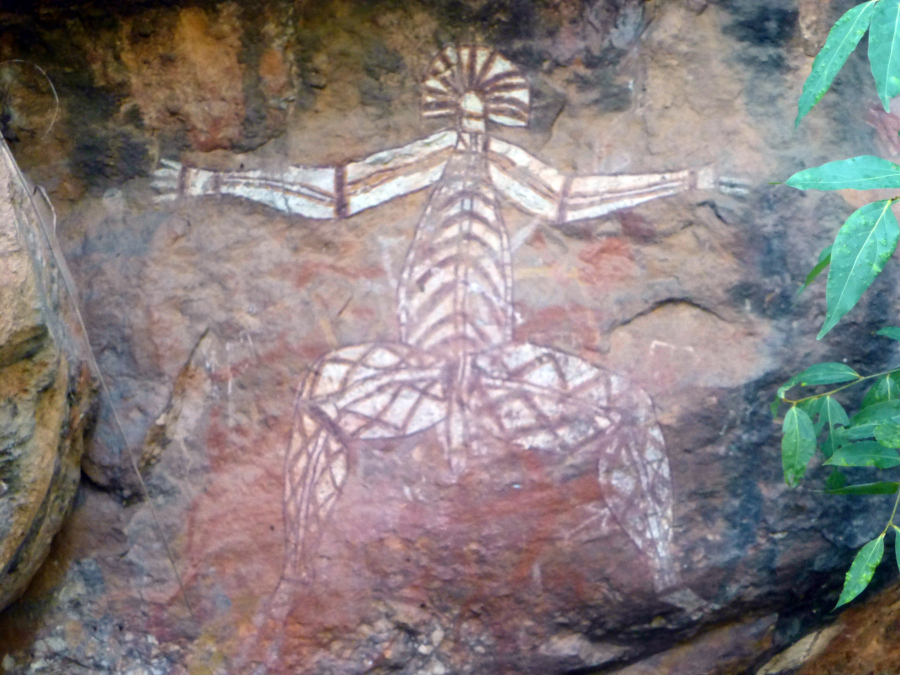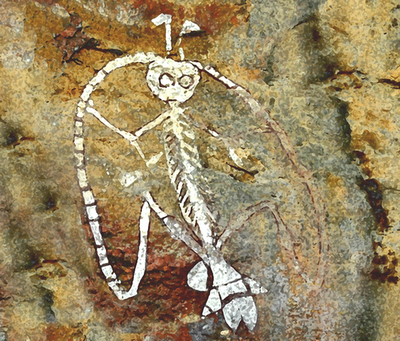NOTE: This article was originally posted to accompany the episode Series 2: The Battle of Moytura – Episode 10: The Children of Tuirenn Part 2 – Three Shouts on a Hill. These are some of the ideas that kicked off the current series dedicated to Dindshenchas!

I am writing this article, or more accurately an addendum to the notes on ‘The Children of Tuireann’ article , in sunny Brisbane. However, I have just returned from a few days in Kakadu in the Northern Territories, a journey that left me thinking. I got to see a lot of estuarine crocodiles, often very large and somewhat close up, but that was not my prime purpose in travelling across the continent. Being a story teller and mythographer, I was after stories, in this instance, first hand exposure to Indigenous Australian stories.
Gunbim, the indigenous rock art, is impressive, especially in this region, but takes a bit of getting your head around. Archaeologists have indicated that there has been continuous human activity here for around 50,000 years. The oldest rock paintings, they say, can be dated back around 20,000 years.
A site, such as Burrunggui (erroneously known as Nourlangie Rock), contains images from both the ‘Estuarine’ and ‘Fresh Water’ periods, including the, most recent ‘Contact’ period. However the paintings have been laid  and overlaid over the centuries. At the Anbangbang gallery, I found myself somewhat confused when the indigenous interpreter introduced us to some magnificent images of, among others, Namarrgon. He is ‘Lightning Man’, with his stone axes attached to head, elbows and knees. We were informed that this was an ancient painting, and yet I had read that the image had been created in 1964 by one of the last great rock painters of the region. Our guide agreed that this was so and added more fascinating information on the artist.
and overlaid over the centuries. At the Anbangbang gallery, I found myself somewhat confused when the indigenous interpreter introduced us to some magnificent images of, among others, Namarrgon. He is ‘Lightning Man’, with his stone axes attached to head, elbows and knees. We were informed that this was an ancient painting, and yet I had read that the image had been created in 1964 by one of the last great rock painters of the region. Our guide agreed that this was so and added more fascinating information on the artist.
Suddenly, the seemingly contradictory information came into sharp focus. It was almost like staring into one of those old ‘magic eye’ pictures and watching the hidden picture emerge. Perhaps the the tropical heat had caused my brain to diffuse and my storyteller’s brain took over the vacuum.
These are ‘Dreamtime’ images. The ‘Dreamtime’ is not, as I might have once considered, a mythic time and no time, when the Ancestors created, and are still creating, the Land. In some ways, it is much simpler. The Dreamtime is a library into which the Elders of the People have placed the knowledge, understandings and rules of living on the ‘Land’. These rock images are effectively ‘books’ that encode this information. The contents, i.e. styles, denote the age of the stories. After all, we do not deny the antiquity of a Shakespeare play or ‘The Children of Tuireann’ just because it is being read in a modern printing. Of course, early texts are extremely helpful in establishing story development, but it is the language and style that corroborate the dating.
OK, I digress, but not that far. The ‘Dreamtime’ library also contains information on djang, dreaming sites. These are sites of power, established by the Nayuhyunggi, the First People. These sites might offer gifts or skills to the ‘right’ visitor, but could, more likely, cause sickness and disaster if approached. For example, the Namarrgondjahdjam, the ‘Lightning Dreaming’, can be seen from Burrunggui. This site, it is warned, is very dangerous. Here Namarrgon left his eye on a high cliff as he travelled across the land. To approach this place, by accident or design, may release devastating lightning storms.
In another example, Bula, the Rainbow Snake and Creation Ancestor of the Jawoyn people, travelled through Stone Country, forming the landscape. While hunting for the edible Pandannus wasp, he accidentally tried to eat Jokbarl, the dangerous hornet. Jokbarl stung him, and in his pain, Bula went underground. He is still there today, and is angered by any disruption to the landscape. This area is known as the ‘Sickness Country’. Curiously, this area, around Jabiru, was where uranium was discovered and mined until fairly recently.
There are a variety of dreaming sites. Many are mounds or cairns, but others are lowland rocks or arrangements of stones. It struck me that there were strong resonances between these djang and some of the sites referred to in the article entitled ‘Three Shouts on a Hill’. Maybe these places of unpredictable challenge and danger represent a concept that is extremely ancient.
In a living land, stories guide the wary traveller, offering sources for food and shelter and protection from danger. There may be gifts and surprises along the way, but there will also be challenges and tests.
In the Irish tales, the Dindshenchas serve a similar purpose, encoding the stories of the land. The Aboriginal peoples of Australia would have found the concept familiar.
And Brian? There would certainly have been Gunbim with advice suggesting he left the hill strictly alone.
April ’13
